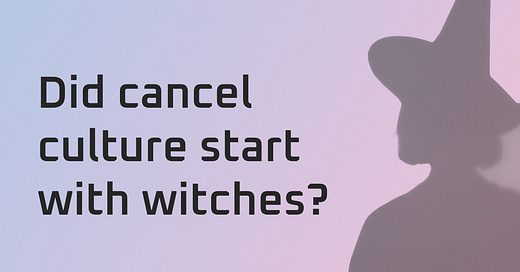I’ve become obsessed with witches in recent months. Witches and the history of gossip have been closely intertwined throughout history; groups of women who talk amongst themselves were often branded as “cults,” or worse, were quite literally killed.
Calling women “witches” has always had a dual purpose—it simultaneously diminishes a woman’s power and discourages other women from following that path. For example, our modern-day use of “witches” still references powerful women who do things that others don’t like (i.e. AOC’s “coven of witches”). Reading between the lines—the subtle implication has always been that when women rise in the ranks, it couldn’t have been without a bit of black magic.
In my research for this essay, I stumbled upon this description of a witch. I think it might be my favourite:
“They were believed to join with the Devil, meet with him at night-time sabbaths, pledge homage, engage in lurid sex, kill children and maim pregnant women. They were also believed to make men impotent – in some cases by actually stealing their genitals.”
LOL. On a not-so-funny note, witches have long personified society’s fear of assertive women. Many powerful women in history like Joan of Arc, Cleopatra, and Anne Boleyn were all accused of being witches. Women who were actually put to trial or killed for allegedly practicing witchcraft were often marginalized in society at the time: they were single, widowed, immigrants, midwives, or village healers. Single women in particular were an easy target to explain away mysterious happenings in society—they lacked a male “protector” or the money to defend themselves.
Interestingly, witches were not always women. Many folks punished for witchcraft were also men, but they tended to be men associated with female witches (eg. brothers, sons, or husbands). Between the years 1500 and 1660, up to 80,000 suspected witches were put to death in Europe. Around 80% of that group were thought to be in cahoots with the devil, and of course, filled with lust.
The feminization of witchcraft was cemented by Heinrich Krämer, when he wrote the 1487 book, Malleus Maleficarum (translation: Hammer of Witches). The book, which became hugely popular, described the nature of witchcraft and the appropriate punishment for witches. Krämer also wrote letters to the pope in which his gender-specific views in relation to witchcraft rang through. Kramer painted witches as “women who abjured the faith,” which they did by allegedly having sex with male demons (could male demons be modern-day fuckboys? I digress). Kramer was equally convinced that midwifery was a form of witchcraft. To Krämer, male heresy was intellectual and theological, whereas women were demonic and sexual. Modern researchers see this as an attempt to control female behavior through legal pressure (this era also coincides with a general crackdown on the role of women in society).
I’ll admit, the history of witches is…depressing. While men certainly policed women for being witches, female neighbors did too. This explainer on witches by Madeline Miller, the author of Circe and The Song of Achilles, resonated deeply:
“In the late 19th century, the suffragette Matilda Joslyn Gage asserted something revolutionary. The persecution of witches, she said, had nothing to do with fighting evil or resisting the devil. It was simply entrenched social misogyny, the goal of which was to repress the intellect of women. A witch, she said, wasn’t wicked. She didn’t fly on a broomstick naked in the dark or consort with demons. She was, instead, likely to a woman with “superior knowledge”. As a thought experiment, she suggested that for “witches” we should read instead “women”.
Perhaps Diem is full of modern-day witches?
I like to think so.
This Week’s Diem Commentary…
👀 Do you find yourself using “weak language” at work or in your personal life to make others feel comfortable? Join the conversation.
👀 Can I still be a feminist and want a marriage/wedding? Add your take (to get access to our salon playbook and host one with your friends!)
👀 What should I know about PCOS treatments? Help out this recently diagnosed Diemer.
👀 Any tips before trying swinging with my partner? Share your wisdom.
👀 Can someone pls explain to me how menstrual cups work? Like how do you get it out without a massacre scene in your bathroom???? We all need to know.
👀 I’m literally so unprepared with my personal finances and I have absolutely no savings or even know where to start… what did you do? Is/was this also you? Help this Diemer out!
Join these conversations in Diem via our web, iOS or Android app!
FYI! We launched the Diem app—Diem is designed to embrace the whims, questions, and hushed conversations that women have been having “behind closed doors” for centuries. Our community talks about topics just like this newsletter every day. Join us via web, iOS or Android.
If you want to try Diem before downloading, text your personal, funny, important, and thought-provoking questions to +1 (518)-855-3436 — (🇺🇸 #s only atm!)



